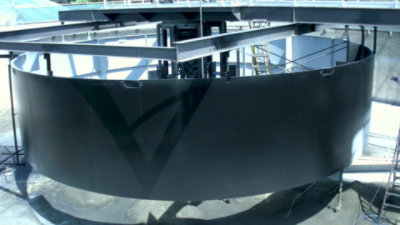The Basics of Sewer Lift Operation, Maintenance, & Repair
Wastewater lift stations are essential infrastructure for sewage collection systems across municipalities, industrial properties, and commercial facilities. Unfortunately, as these assets age, they can start leaking, corroding, backing up, or failing. It’s more important than ever to ensure sewer lift stations operate at peak functionality, which requires regular maintenance and, eventually, rehabilitation.
By planning ahead, carrying out routine inspections, repairing broken components, and taking preventative measures, you can ensure sewer lift stations are performing as expected.

What Are Wastewater Lift Stations?
Sewage collection and transportation systems are critical pieces of infrastructure. They use wastewater lift stations, also known as pumping stations, to move wastewater through pipes in areas where the elevation or depth of the pipe makes gravity ineffective.
As sewage moves through underground pipes, the system relies on gravity to ensure the wastewater flows from higher to lower elevation. In some places, the pipes move from lower to higher elevation areas, making the gravity pipeline system ineffective without costly solutions like digging trenches. Wastewater lift stations are often installed at points where the elevation of the wastewater source is lower than the destination and gravity cannot move the sewage on its own. Instead, these sewer lift stations pump the wastewater from the lower elevation areas to the higher elevation areas of the collection system, ensuring the entire system continues to operate efficiently.
The Basics of Sewer Lift Station Operation
Raw sewage is transported via sloped pipes stored underground toward a wastewater collection and treatment plant. This system takes advantage of gravity to move wastewater from higher elevated areas to lower elevated areas, a process that is not only extremely efficient but also saves on sewer construction and excavation costs.
However, in some situations, sewage enters the pipe from areas of lower elevation, making it impossible to use gravity to move the wastewater up to a higher area. Wastewater lift stations are an affordable solution for this issue.
As sewage moves through the pipes and reaches the wet well (a temporary storage container), the wastewater is tested and the sewage levels in the container are monitored with electrical instrumentation. When the wet well reaches a predetermined level, two or more sewer lift station pumps “lift” the wastewater upwards using a system of pressurized pumps and compressors to an area of higher elevation. Then, at this higher point, gravity can once again guide the sewage to its destination: the wastewater treatment plant or, if needed, the next lift station.
Wastewater lift station operation is often automated, so it does not require continuous, on-site monitoring or human intervention. However, they require regular attention. It is essential to frequently inspect and conduct routine maintenance so that problems can be avoided and the system can continue to work as designed.
Repairing & Maintaining Wastewater Lift Stations
Lift station maintenance requires regular inspections, preventative actions, and repairs or rehabilitation when issues arise. These systems are under constant stress and are susceptible to clogs and backups. Failures can lead to flooded buildings, bad odors, sewage spills, and more. Fortunately, a comprehensive sewage lift station maintenance program including both routine and preventative actions helps reduce downtime, prevent equipment wear and tear, and avoid disaster.
Wastewater lift stations with clogged pumps, electrical or communication failures, safety concerns, or piping or concrete that is corroding or otherwise damaged are all signs that lift station rehabilitation may be required.
Lift station rehabilitation involves inspecting, repairing, and protecting components of the lift station to prolong their long-term use and ensure they operate at peak efficiency.
The Benefits of Protective Coatings & Linings for Lift Station Rehabilitation
Wastewater lift stations must follow a variety of safety and environmental standards to ensure the system operates efficiently, safely, and reliably. Not only should the system be designed to prevent sewage from pouring into the environment due to leaky or corroded pipes, but it should also include a variety of safety features such as alarms and emergency stop buttons.
An essential part of lift station rehabilitation is preventing pipes, water wells, pumps, and other steel or concrete infrastructure from degrading or corroding. Wastewater naturally generates hydrogen sulfide (H2S), which corrodes pipes and damages concrete. H2S, moisture, and wear and tear can damage hatches, pipelines, valves, pumps, and more.
Anti-corrosive pipe linings and coatings serve as a protective barrier on the exterior and interior of the pipe, preventing the sewage from corroding the inside of the pipe as well as stopping wastewater from leaking outside of the pipe.
Lift station coatings and linings are specially designed to work long-term in the corrosive, moist environment of sewer collection and transportation systems. The ideal coating and lining system is resistant to moisture, abrasions, impacts, corrosion, chemical attacks, and more. They must be extremely durable as well as flexible to survive the daily wear and tear of wastewater lift station operation.
To prevent costly corrosion and damage to essential components of a wastewater lift station, install epoxy or polyurethane coatings and linings.


Contact Sherwin-Williams for Lift Station Coatings & Linings
Sherwin-Williams is the leading provider of coatings and linings for the water and wastewater industry. Our line of high performance sewer and wastewater collection coatings and transmission pipe linings offers superior resistance to corrosion, impacts, abrasions, and chemical attacks. With our durable, flexible, and long-lasting lining and coating solutions, you can extend the service life of your sewer and wastewater infrastructure and experience cost savings for years to come.
Contact a Sherwin-Williams Coatings Specialist today to learn more about our strong, low maintenance, anti-corrosive, and chemical resistant coating and lining products for wastewater lift stations and sewer collection systems.
Discover More
Industry Expertise and Innovation
See how we help customers find customized solutions for their project and application challenges.


